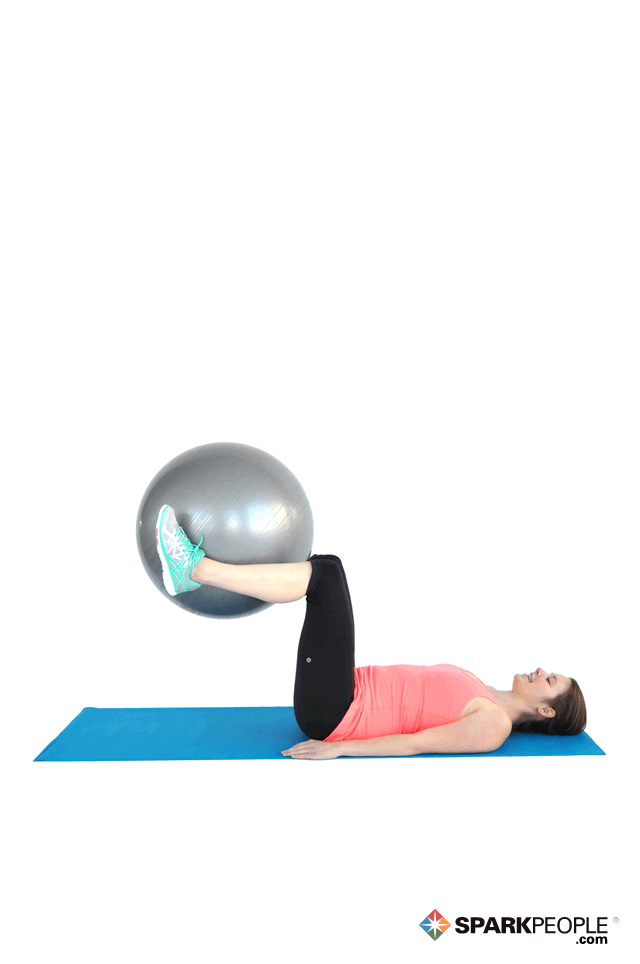


This version forces you to more efficiently use your abs to resist the weight. The farther you straighten your legs, the harder the exercise the closer your heels are to your hips, the easier the exercise. If it's too easy to lower your legs without allowing your lower back to arch off the floor while keeping your knees bent, simply extend your legs farther as you lower them. Once your heels lightly touch the floor, reverse the motion and bring your knees back above your hips. When lowering your legs, start with the knees bent. Maintaining tension against the band with your arms, slowly lower your legs toward the floor without allowing your lower back to come off the floor.

In each hand, hold the handle of a resistance band that's attached to a stable structure behind you about 12 inches off the floor. Lie on your back on the floor with your knees bent, your hips flexed above 90 degrees, and your arms outstretched in front of your torso, just below shoulder level. Sometimes the gung-ho types have their training partner throw their legs back down toward the floor as they resist the force, which is the worst version of this move for most people. Sometimes they've got their hands jammed underneath their ass and other times their holding on to a partner's ankles. Someone's lying on the floor on their back with their legs in the air and they're raising and lowering them. Reducing any leg kicking forces your abs to do more work. Make it even more difficult by doing it lying on an incline bench with your head higher than your legs. Don't allow your legs to extend or your head to lift off the ground at any point. Slowly reverse this motion, lowering your spine back down one vertebra at a time. In a controlled fashion, perform a reverse crunch by rolling your lower back up off the floor and bringing your knees toward your chin. If you're on the floor, hold on to a solid object above your head. With your elbows slightly bent, hold on to the bench just behind and above your head. Lie on your back on a weight bench or on the floor with your knees bent and your hips flexed into your belly. So if you're unable to perform hanging leg raises in the way described above (most people aren't strong enough), start with reverse crunches and progress from doing them on a flat bench and then doing them on an incline. This is basically a less advanced version of the hanging leg raise. Tuck your pelvis and you'll target the abs better. Although this certainly involves the abs, the degree of involvement is negligible. The way these exercises are usually performed – with your legs hanging down and flexing at your hips – is primarily a hip flexion exercise. Here's how it looks in a "captain's chair" machine: Don't use momentum or jerk your body at any point. Slowly reverse this motion without allowing your knees to become un-tucked from your body. In a controlled fashion, roll your torso upwards, bringing your knees toward your chin. Flex your hips and bend your knees, holding them above your hips in front of your torso. Hang from a pull-up bar with an overhand grip and your hands roughly shoulder-width apart. That's mostly a hip flexor exercise, not an ab exercise. They start with their legs hanging straight down then flex at their hips. Whether you're hanging from a pull-up bar, have your elbows in those ab straps, or you're on a machine, the leg raise is a great exercise. You can create the same training effect with a cable and use much lower loads. Now, you could certainly hold very heavy dumbbells, but they may exceed your grip strength. But when doing them with a cable or stretch band, the angle of the cable forces you to work hard to stay upright and maintain that position between reps, giving you more time under tension through the range of motion. There's not much resistance when you're standing upright holding a dumbbell because the dumbbell is very close to your body, giving you a huge mechanical advantage over the weight. Reverse the action and finish the rep by slightly flexing your torso to the left against the resistance. Without rotating your body, slightly bend your torso sideways to the right until you feel a mild stretch in the left side of your torso. Make sure you're standing far enough away from the cable or band so that it's at roughly a 45-degree angle to the floor. Stand tall with your cable at your right side with your feet about shoulder-width apart. Grab the handle of a cable (or resistance band) that has a low attachment, roughly ankle level with your right hand. But the weight on one side offsets the weight on the other, making this exercise pretty ineffective at loading the lateral flexors of the torso. And many people do it by holding two dumbbells, one on each side. You see it all the time in the gym, but this exercise doesn't make biomechanical sense.


 0 kommentar(er)
0 kommentar(er)
